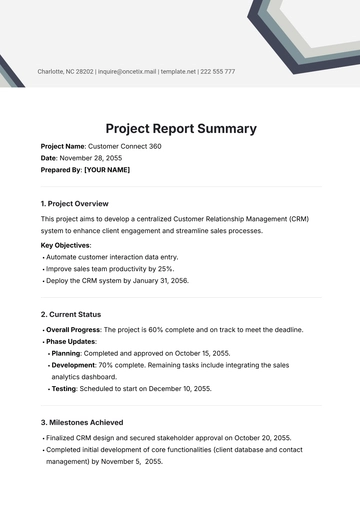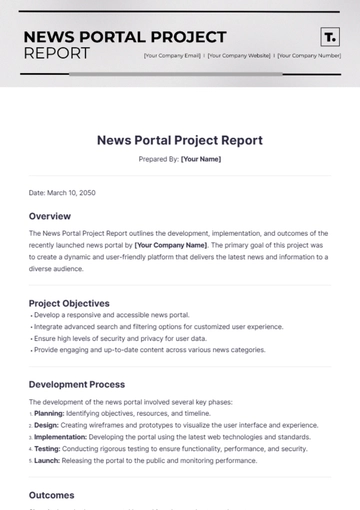Free Project Steering Committee Report

I. Introduction
The Project Steering Committee Report provides a comprehensive overview of the project's progress, challenges, and strategic direction as overseen by the Project Steering Committee at [Your Company Name]. This report is designed to offer stakeholders a detailed account of project status, including key achievements, risks, and upcoming milestones. The Steering Committee plays a crucial role in ensuring that the project aligns with the company’s strategic goals, adheres to budget constraints, and meets established deadlines.
In this report, we will review the project’s current phase, highlight any significant issues encountered, and outline the strategies implemented to address these challenges. Additionally, the report will include an assessment of resource allocation, stakeholder engagement, and any deviations from the project plan. The aim is to provide a transparent and actionable summary that facilitates informed decision-making and ensures continued alignment with [Your Company Name]'s overall objectives.
II. Key Findings
This section presents a detailed analysis of the project's progress, performance metrics, and challenges encountered. By evaluating various aspects such as project milestones, sales outcomes, and operational improvements, we aim to provide a comprehensive understanding of the project's impact. Additionally, identifying the key challenges faced allows for the development of targeted strategies to address these issues and enhance overall project effectiveness. The findings presented here are critical for assessing the project's alignment with [Your Company Name]'s strategic goals and for making informed decisions regarding future actions and adjustments.
Project Progress |
The project is about 60% complete as of the latest review. Significant milestones achieved include the integration of advanced CRM tools, initial training of sales personnel on new digital platforms, and the successful launch of the pilot program in two regions. |
Sales Performance |
Post-implementation data shows a 15% increase in lead generation and a 10% improvement in sales conversions in the pilot regions compared to traditional methods. Customer feedback indicates a higher satisfaction rate due to more personalized and efficient interactions. |
Operational Efficiency |
The automation of routine tasks has reduced the manual workload on sales representatives, allowing them to focus more on strategic customer engagement. This shift has increased overall productivity by approximately 20%. |
Challenges Identified |
Despite the progress, several challenges have been identified, including resistance to change among some team members, technical glitches in the CRM integration, and the need for ongoing training and support to ensure the adoption of new processes. |
III. Detailed Analysis
In exploring the core elements of the project, we examine the integration of advanced CRM tools, training and skill development, change management strategies, and performance metrics. Each area provides insights into the project's effectiveness and areas for improvement. By addressing technical challenges, refining training programs, managing resistance, and tracking performance metrics, we aim to enhance the overall success of the project. The following analysis offers a detailed perspective on these crucial aspects, guiding necessary adjustments and ensuring alignment with [Your Company Name]'s strategic objectives.
1. Integration of Advanced CRM Tools
The integration of advanced CRM tools has streamlined customer data management and enhanced data-driven decision-making. However, technical issues such as data migration errors and intermittent system downtimes have been obstacles. These issues require immediate attention to prevent disruptions in sales operations.
2. Training and Skill Development
The initial training sessions have been successful in familiarizing the sales team with new tools, but continuous skill development programs are essential. Regular workshops and digital learning modules should be implemented to ensure proficiency and confidence in using new platforms.
3. Change Management
Resistance to change remains a significant hurdle. A structured change management plan, including clear communication of benefits, involvement of key stakeholders, and incentivization strategies, is critical to enhance buy-in and reduce resistance.
4. Performance Metrics
The pilot projects have demonstrated positive outcomes in terms of performance metrics. It is essential to implement comprehensive tracking mechanisms to monitor ongoing performance, identify areas for improvement, and refine strategies as the project progresses.
IV. Recommendations
To address the identified challenges and enhance project outcomes, several key recommendations are proposed. These include resolving technical issues with CRM integration, expanding training programs to ensure comprehensive skill development, strengthening change management efforts to overcome resistance, and implementing continuous performance monitoring to track progress. By focusing on these areas, [Your Company Name] can effectively address current obstacles, improve overall project execution, and achieve the desired strategic goals. The following recommendations provide actionable steps to optimize project success and ensure alignment with organizational objectives.
1. Address Technical Glitches
Immediate actions should be taken to resolve technical issues in CRM integration. Engaging with IT experts, conducting regular system checks, and setting up a dedicated support team will be crucial in mitigating these risks.
2. Enhance Training Programs
Expand on the existing training programs by incorporating ongoing digital learning modules, peer-to-peer sessions, and regular workshops. Tailored training materials should be developed to cater to varying levels of expertise within the team.
3. Strengthen Change Management Efforts
Develop a comprehensive change management strategy that includes clear communication of the project's benefits, involvement of employees in the transition process, and motivational incentives to encourage adoption of new tools and processes.
4. Implement Continuous Performance Monitoring
Establish a robust performance monitoring framework to continuously track key metrics such as lead generation, sales conversions, and customer satisfaction. Utilize this data to make informed decisions and adjust strategies as needed.
V. Conclusion
The digital transformation project within the sales department at [Your Company Name] is demonstrating substantial progress, marked by the successful achievement of key milestones and positive impacts on sales performance and operational efficiency. The integration of advanced CRM tools and the initial phases of training have contributed to a notable increase in lead generation and sales conversions. The automation of routine tasks has further enhanced productivity, underscoring the project's overall effectiveness in streamlining operations and driving growth.
However, to maintain and build upon this momentum, it is essential to address the technical challenges identified, such as data migration errors and system downtimes. Enhancing training programs to ensure ongoing skill development and strengthening change management efforts to mitigate resistance will be crucial. Implementing continuous performance monitoring and making data-driven adjustments will ensure that the project remains on track and aligned with its strategic objectives. By focusing on these areas, [Your Company Name] can ensure that the digital transformation project delivers sustained benefits, supporting long-term success and contributing to the organization's overarching goals.
- 100% Customizable, free editor
- Access 1 Million+ Templates, photo’s & graphics
- Download or share as a template
- Click and replace photos, graphics, text, backgrounds
- Resize, crop, AI write & more
- Access advanced editor
Keep stakeholders informed with Template.net's Project Steering Committee Report Template. Fully editable and customizable, this template helps you present key project updates, decisions, and recommendations. Easily tailor it to your project’s requirements, editable in our Ai Editor Tool, for a professional report that ensures transparent communication and effective project governance.
You may also like
- Sales Report
- Daily Report
- Project Report
- Business Report
- Weekly Report
- Incident Report
- Annual Report
- Report Layout
- Report Design
- Progress Report
- Marketing Report
- Company Report
- Monthly Report
- Audit Report
- Status Report
- School Report
- Reports Hr
- Management Report
- Project Status Report
- Handover Report
- Health And Safety Report
- Restaurant Report
- Construction Report
- Research Report
- Evaluation Report
- Investigation Report
- Employee Report
- Advertising Report
- Weekly Status Report
- Project Management Report
- Finance Report
- Service Report
- Technical Report
- Meeting Report
- Quarterly Report
- Inspection Report
- Medical Report
- Test Report
- Summary Report
- Inventory Report
- Valuation Report
- Operations Report
- Payroll Report
- Training Report
- Job Report
- Case Report
- Performance Report
- Board Report
- Internal Audit Report
- Student Report
- Monthly Management Report
- Small Business Report
- Accident Report
- Call Center Report
- Activity Report
- IT and Software Report
- Internship Report
- Visit Report
- Product Report
- Book Report
- Property Report
- Recruitment Report
- University Report
- Event Report
- SEO Report
- Conference Report
- Narrative Report
- Nursing Home Report
- Preschool Report
- Call Report
- Customer Report
- Employee Incident Report
- Accomplishment Report
- Social Media Report
- Work From Home Report
- Security Report
- Damage Report
- Quality Report
- Internal Report
- Nurse Report
- Real Estate Report
- Hotel Report
- Equipment Report
- Credit Report
- Field Report
- Non Profit Report
- Maintenance Report
- News Report
- Survey Report
- Executive Report
- Law Firm Report
- Advertising Agency Report
- Interior Design Report
- Travel Agency Report
- Stock Report
- Salon Report
- Bug Report
- Workplace Report
- Action Report
- Investor Report
- Cleaning Services Report
- Consulting Report
- Freelancer Report
- Site Visit Report
- Trip Report
- Classroom Observation Report
- Vehicle Report
- Final Report
- Software Report





























